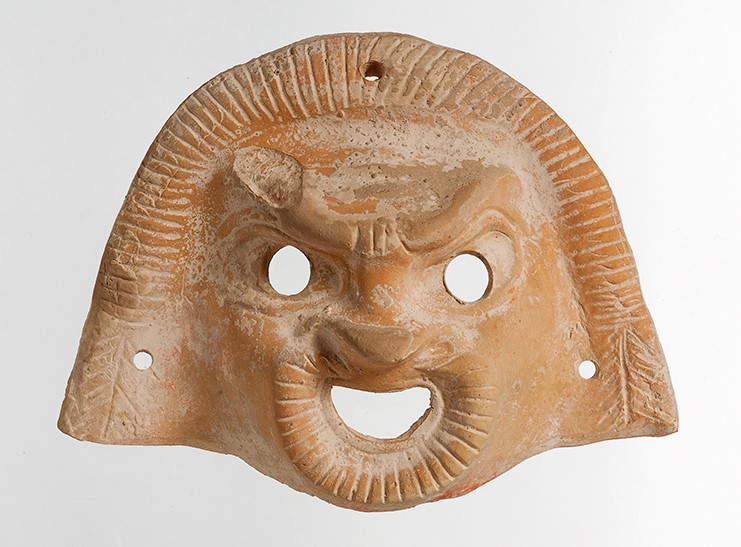Acquisition number: 1991.04
Intact and in good condition save for an ancient chip from the right brow and some wear on the nose and brows.
Somewhat grey pale brown clay, fairly coarse with a number of large white and dark brown inclusions. Pale orange-brown slip. The detail of the hair and beard were worked up after removal from the mould. Circular holes are cut out for the eyes and an opening for the mouth. There are three suspension- or tie-holes, one above and one to each side. There are some traces of red about the face.
The reverse shows clearly where and how the sheet of clay was pressed into the mould: in a broad band behind the hair, in a quick and forceful line behind the brows, in a rough circle around the mouth, and then in a line down the nose.
Title: Terracotta Mask - 1991.04
Acquisition number: 1991.04
Author or editor: J.R. Green
Culture or period: Roman Imperial
Date: AD 50 - 150.
Material: Clay - Terracotta
Object type: Sculpture and figurines
Dimensions: 201mm (w) × 152mm (h)
Origin region or location: Türkiye
Display case or on loan: 12
Keywords: Roman, Imperial, Figurine, Mould Made, Eastern Mediterranean, Roman Asia, Egpyt
Sotheby (New York), Sale Cat., 18 June 1991, no. 243 (ill.); J.R. Green et al., Ancient Voices – Modern Echoes: Theatre in the Greek World (Nicholson Museum, University of Sydney, 2003) 60 no. 17 (colour ill.).
1991.04
Terracotta Mask
Presented by the Friends of the Classics Museum. Ht 15.2cm.; width 20.1cm.
Intact and in good condition save for an ancient chip from the right brow and some wear on the nose and brows.
Somewhat grey pale brown clay, fairly coarse with a number of large white and dark brown inclusions. Pale orange-brown slip. The detail of the hair and beard were worked up after removal from the mould. Circular holes are cut out for the eyes and an opening for the mouth. There are three suspension- or tie-holes, one above and one to each side. There are some traces of red about the face.
The reverse shows clearly where and how the sheet of clay was pressed into the mould: in a broad band behind the hair, in a quick and forceful line behind the brows, in a rough circle around the mouth, and then in a line down the nose.
This example is one of a large series of such masks (cf. Monuments Illustrating New Comedy (3rd ed. rev. and enlarged by J.R. Green and Axel Seeberg, BICS Suppl. 50, 1995) i, 99-102). They are all roughly similar and have been found throughout the Roman Empire, particularly its eastern half. Ours belongs on the lower side of the size-range which runs from about 15 to 27cm in height, with the average being ca 18-20cm. The three fastening holes are standard. The irises are always pierced (usually with a larger circular cut-out than here), most often the mouth also, and sometimes the nostrils. As a rule the modelling is summary, and there is little depth. Paint traces are often present, and a gaudy colouring seems to have been normal.
For other generally similar pieces derived from masks of comic slaves, see Pergamon T 430 (E. Töpperwein, Terrakotten von Pergamon [PergForsch 3, 1976] no. 525, pl. 76; Monuments Illustrating New Comedy (3rd ed. rev. and enlarged by J.R. Green and Axel Seeberg, BICS Suppl. 50, 1995) 5XT 12b) and the fragmentary piece from Tarsus in the Louvre (T 557, S. Besques, Catalogue raisonné des figurines et reliefs en terre-cuitegrecs, étrusques et romains, iii. Epoques hellénistique et romaine. Grèce et Asie Mineure [Paris 1972], E/D 3031, pl. 434, Monuments Illustrating New Comedy 3 5XT 11).
No doubt because of their size, these masks have attracted a great deal of attention, but their relationship to theatre practice is not close and the borrowings from the appearance of actual stage masks is rather generalised. Ours, for example, is derived from that of a comic slave without having the details consistent. For the moment their function remains unclear. Apart from the fact that clay would be uncomfortable to wear (because of its weight, roughness and lack of flexibility), they are too flat for ready use and quite a number have the mouth closed. Many (like this one) are too small. The find-contexts show that they were not made for the tomb even though many have been found in graves. For example a number of fragments of masks of this kind have been found in association with a bath building adjoining the Agora of Thessalonike: P. Adam-Veleni, “Βαλανείο προγενέστερο της Αγοράς Θεσσαλονίκης”, Το Αρχαιολογικό Έργο στη Μακεδονία και Θράκη 11, 1997 [1999], 351-364.
Part of a mould for the manufacture of masks of this kind (in this case representing a youth) was found some while ago among the debris of a coroplast’s workshop in Chalkis in Euboea: Archaiologike Ephemeris 1980, 153, 163, pl. 58, 93.
Most indications of date for the series point to the period AD 50-150, but some are certainly later, and some may well be earlier. The treatment of the eyes of our piece is dependent on Augustan style, but the relatively small mouth is a later feature and a date in the later first or earlier part of the second century AD is likely.
Sotheby (New York), Sale Cat., 18 June 1991, no. 243 (ill.); J.R. Green et al., Ancient Voices – Modern Echoes: Theatre in the Greek World (Nicholson Museum, University of Sydney, 2003) 60 no. 17 (colour ill.).
